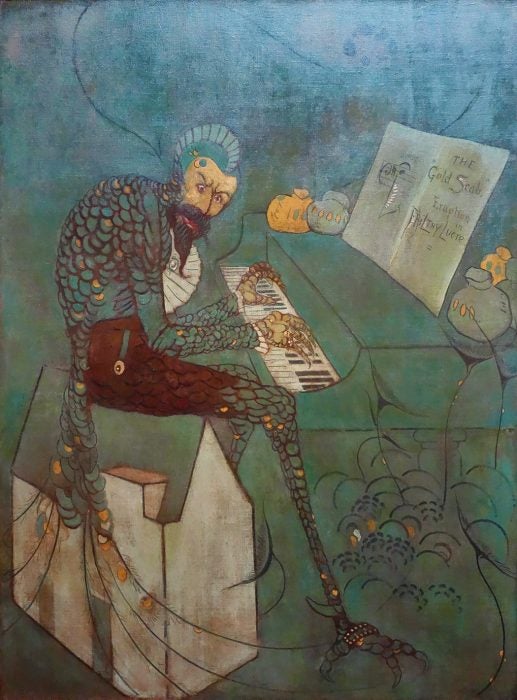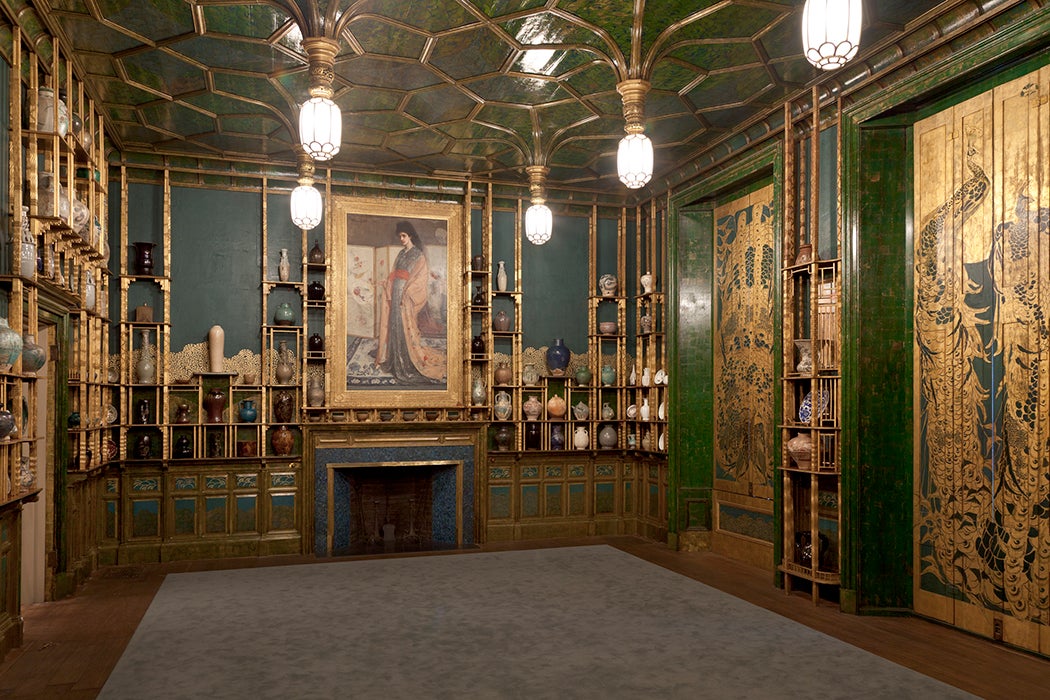In 1876, shipping magnate Frederick Leyland left his London home. In his absence, the artist James McNeill Whistler was tasked with lightly revamping the dining room so its leather wall hangings would complement Whistler’s painting “The Princess from the Land of Porcelain.” The room was already a lush space designed by architect Thomas Jeckyll.
Curator Marilynn Johnson Bordes writes in Record of the Art Museum, Princeton University:
Prior to work on the Peacock Room, Jeckyll created other rooms in the Japanese taste, such as a billiard room for Alexander lonides…In the Peacock Room, Jeckyll worked out an elaborate system of shelving to display Leyland’s collection of blue and white porcelain.
Whistler, best known for his demure 1871 painting of his mother dressed in black, had previously painted an elegant and subdued portrait of Leyland. But the artist had something else in mind for Jeckyll’s interior.
Leyland was startled to receive letters from Whistler on the radical redesign of his dining room and its great expense. He wrote to Whistler from Liverpool on October 21, 1876, blaming him for “not letting me know before developing into an elaborate scheme of decoration that was intended to be a very slight affair and the work of comparatively a few days.”
Leyland returned in 1877 to discover a showy chamber of gold and blue inspired by peacock plumage. Peacocks were painted on the shutters; even the ceiling was consumed by design. Art historian David Park Curry describes the transformation in Studies in the History of Art:
[Whistler] capitalized upon the reflective surfaces of Dutch metal and gilt paint to lighten the dark, potentially gloomy space. Endless gold peacock feathers enrich the surfaces of the room. The very thickness of the paint picks up the light as would a faceted jewel; at the same time that sheer multiplicity overwhelms the viewer with a sense of repeated pattern that tends to flatten all surface planes.
Whistler was proud of the work, and showed it off to friends and the press, much to Leyland’s chagrin. He was not pleased that this private space had become a public showpiece for Whistler. Art historian Anne Anderson writes in Victorian Literature and Culture that “the publicity Whistler hoped would enhance his professional reputation was equally sure to offend his retiring patron. Leyland believed the artist to have overstepped the terms of the commission and declared, ‘his dining-room was ruined and Whistler’s time wasted.’”
Worse for Whistler, he didn’t get the grand sum of 2,000 guineas from Leyland that he thought his work was worth. Whistler fumed in a July 1877 letter: “It is positively sickening to think that I should have labored to build up that exquisite Peacock Room for such a man to live in!”
With the loss of his patron—and a reluctance from other wealthy figures to let the bombastic artist into their homes—Whistler was soon bankrupt. He painted a scathing caricature of Leyland entitled “The Gold Scab, Eruption in Frilthy Lucre” which turned the color scheme of the Peacock Room into a grotesque representation of greed.
Weekly Newsletter
“When, in 1879, he was forced to leave his beloved home and studio, the White House, he arranged to have ‘The Gold Scab’ and perhaps two other satirical pictures waiting in the studio to greet Leyland, now one of a committee of creditors, for his official inspection,” writes art historian Kirk Savage in Smithsonian Studies in American Art. “Leyland saw himself depicted as a ghoulish human-peacock hybrid, clad in his customary frills, surrounded by moneybags, and seated on the sharp-edged rooftop of a miniature White House.”

The controversy remains part of the Peacock Room’s lore even as it’s now considered Whistler’s interior masterpiece. Leyland himself must have grown to like it or at least appreciate it as a significant work of art as he never had it changed. Following his death in 1892, it was acquired by American industrialist Charles Lang Freer in 1904 and reassembled in his Detroit home. After Freer’s death in 1919, it made another journey to Washington, D.C., where it is now in the Freer Gallery of Art. This May, its latticework shelving was filled with 170 pieces of blue-and-white Chinese porcelain similar to Leyland’s now dispersed collection. For the first time in decades, visitors can again witness the infamous room as Whistler intended and experience the decadence that so shocked its unwitting patron.







